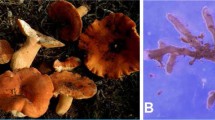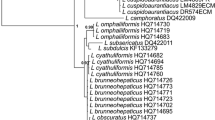Abstract
Guatemala is one of the richest biodiversity hotspots worldwide, bursting a wild array of ecosystems that range from pine and mixed forests in the highlands to tropical rain forests in the extensive El Petén area, bordering Belize and Mexico. Despite this biological wealth, however, current knowledge on the Guatemalan mycobiota is particularly scant, in part because of the prolonged civil war that has prevented exploration of many ecological niches. In the present paper, we report on the occurrence of Lactarius rimosellus Peck—a rarely discussed species—in oak-pine mixed forests in the Guatemalan highlands and describe the relevant ectomycorrhizae formed with Quercus sp. by means of molecular and morpho-anatomical tools. On the phylogenetic trees constructed on the basis of the partial LSU sequence, sporocarp- and ectomycorrhizae-derived sequences formed a common, statistically supported clade. The structural features of the ectomycorrhizae of L. rimosellus were generally found to match those described on various hosts for other Lactarius species belonging to the subgenus Russularia, where L. rimosellus has been traditionally assigned. These mycorrhizae are characterized by a pseudoparenchymatous outer mantle layer, with epidermoid or angular hyphal cells, and a plectenchymatous inner mantle layer; lactifers are embedded either in the middle and/or inner mantle layer. In the framework of a more general, ongoing study of the ethnomycology of the Maya populations in the Guatemalan highlands, we also report on the traditional knowledge about Lactarius mushrooms and their uses among native people.



Similar content being viewed by others
References
Agerer R (1986) Studies on ectomycorrhizas II. Introducing remarks on characterization and identification. Mycotaxon 26:473–492
Agerer R (ed) (1987–2006) Colour atlas of ectomycorrhizas, 1th–13th del. Einhorn, Schwäbisch Gmünd
Agerer R (1991) Characterization of ectomycorrhiza. In: Norris JR, Read DJ, Varma AK (eds) Techniques for the study of mycorrhiza. Methods Microbiol 23:25–73
Altschul SF, Gish W, Miller W, Myers EW, Lipman DJ (1990) Basic local alignment search tool. J Mol Biol 215:403–410
Boa E (2004) Wild edible fungi. A global overview of their use and importance to people. FAO, Rome
Bran MC, Morales O, Cáceres R, Flores R, de Ariza J, Rodriguez E, Garcia F, Alarcón D (2002) Hongos comestibles de Guatemala: diversidad, cultivo y nomenclatura vernácula (Fase II). Informe Técnico Final. Dirección General de Investigación, Universidad de San Carlos de Guatemala, Guatemala City, Guatemala
Bran MC, Morales O, Cáceres R, Flores R (2003) Contribución al conocimiento de los hongos comestibles de Guatemala. IIQB-USAC. Revista Científica, special issue: 1–24
Bran MC, Morales O, Cáceres R, Flores R, Andrade C, Quezada A, Carranza C, Ariza J, Rodríguez E, Alarcón D (2005) Hongos comestibles de Guatemala: diversidad, cultivo y nomenclatura vernácula (Fase IV). Industria y Alimentos, July-September: 46–50
Brundrett MC (2009) Mycorrhizal associations and other means of nutrition of vascular plants: understanding the global diversity of host plants by resolving conflicting information and developing reliable means of diagnosis. Plant Soil 320:37–77
Comandini O, Rinaldi AC (2008) Lactarius cistophilus Bon & Trimbach + Cistus sp. Descr Ectomycor 11/12:83–88
Eberhardt U, Oberwinkler F, Verbeken A, Pacioni G, Rinaldi AC, Comandini O (2000) Lactarius ectomycorrhizae on Abies alba: morphological description, molecular characterization, and taxonomic remarks. Mycologia 92:860–873
Erős-Honti Z, Kovács GM, Szedlay G, Jakucs E (2008) Morphological and molecular characterization of Humaria and Genea ectomycorrhizae from Hungarian deciduous forests. Mycorrhiza 18:133–143
Filatov DA (2002) ProSeq: a software for preparation and evolutionary analysis of DNA sequence data sets. Mol Ecol Notes 2:621–624
Flores R, Simonini G (2000) Contributo alla conoscenza delle Boletales del Guatemala. Riv Micol 2:121–145
Flores R, Díaz G, Honrubia M (2005) Mycorrhizal synthesis of Lactarius indigo (Schw.) Fr. with five Neotropical pine species. Mycorrhiza 15:563–570
Gronbach E (1988) Charakterisierung und Identifizierung von Ektomykorrhizen in einem Fichtenbestand mit Untersuchungen zur Merkmalsvariabilität in sauer beregneten Flächen. Bibl Mycol 125:1–217
Guindon S, Gascuel O (2003) A simple, fast and accurate algorithm to estimate large phylogenies by maximum likelihood. Syst Biol 52:696–704
Guzmán G (2001) Hallucinogenic, medicinal, and edible mushroom in México and Guatemala: traditions, myths and knowledge. Int J Med Mushrooms 3:399–408
Guzmán G, Torres MF, Logemann H, Argueta J, Sommerkamp I (1985) Fungi from Guatemala, I. A new species of Morchella. Mycol Helv 1:451–459
Halling RE (2001) Ectomycorrhizae: co-evolution, significance, and biogeography. Ann Mo Bot Gard 88:5–13
Hesler LR, Smith AH (1979) North American species of Lactarius. University of Michigan Press, Ann Arbor
Huelsenbeck JP, Ronquist F (2001) MrBAYES: Bayesian inference of phylogeny. Bioinformatics 17:754–755
Hutchinson LJ (1999) Lactarius. In: Cairney JWG, Chambers SM (eds) Ectomycorrhizal fungi. Key genera in profile. Springer, Berlin, p 285
Lowy B (1971) New records of mushroom stones from Guatemala. Mycologia 63:983–993
Lowy B (1972) Mushroom symbolism in Maya codices. Mycologia 64:816–821
Lowy B (1974) Amanita muscaria and the Thunderbolt legend in Guatemala and Mexico. Mycologia 66:189–191
Lowy B (1977) Hallucinogenic mushrooms in Guatemala. J Psychedelic Drug 9:123–125
Montoya L, Bandala VM (2005) Revision of Lactarius from Mexico. Persoonia 18:471–483
Montoya L, Bandala VM (2008) A new species and new records of Lactarius (subgenus Russularia) in a subtropical cloud forest from eastern Mexico. Fungal Divers 29:61–72
Montoya A, Hernández-Totomoch O, Estrada-Torres A, Kong A, Caballero J (2003) Traditional knowledge about mushrooms in a Nahua community in the state of Tlaxcala, México. Mycologia 95:793–806
Morales O, Flores R, Samayoa B, Bran MC (2002) Estudio etnomicológico de la cabecera municipal de Tecpán Guatemala, Chimaltenango. IIQB-USAC. Revista Cientifica 15:10–20
Mueller GM, Halling RE (1995) Evidence for high biodiversity of Agaricales (fungi) in Neotropical montane Quercus forests. In: Churchill S, Balslev H, Forero E, Luteyn J (eds) Biodiversity and conservation of neotropical forests. New York Botanical Garden Press, Bronx, pp 303–312
Mueller GM, Halling RE (2010) Macrofungi of Costa Rica. Available at http://www.nybg.org/bsci/res/hall/. Accessed 30 April 2011)
Munsell Soil Color Charts (2000) Grand Rapids. Munsell Color Company, MI, USA
Nuytinck J, Verbeken A, Leonardi M, Pacioni G, Rinaldi AC, Comandini O (2004) Characterization of Lactarius tesquorum ectomycorrhizae on Cistus sp., and molecular phylogeny of related European Lactarius taxa. Mycologia 96:272–282
Ohi K, Torres MF (eds) (1994) Piedras Hongo. Museo de Tabaco y Sal, Tokyo
Rehner SA, Samuels GJ (1994) Taxonomy and phylogeny of Gliocladium analysed from nuclear large subunit ribosomal DNA sequences. Mycol Res 98:625–634
Rinaldi AC, Comandini O, Kuyper TW (2008) Ectomycorrhizal fungal diversity: separating the wheat from the chaff. Fungal Divers 33:1–45
Ronquist F, Huelsenbeck JP (2003) MrBAYES 3: Bayesian phylogenetic inference under mixed models. Bioinformatics 19:1572–1574
Ruán-Soto F, Garibay-Orijel R, Cifuentes J (2006) Process and dynamics of traditional selling wild edible mushrooms in tropical Mexico. J Ethnobiol Ethnomed 2:3
Smith SE, Read DJ (2008) Mycorrhizal symbiosis, 3rd edn. Academic, San Diego
Sommerkamp Y (1990) Hongos comestibles en los mercados de Guatemala. Dirección General de Investigación-DIGI, Universidad de San Carlos de Guatemala, Guatemala City
Sommerkamp I, Guzmán G (1990) Hongos de Guatemala. II Especies depositadas en el herbario de la Universidad de San Carlos de Guatemala. Rev Mex Micol 6:179–197
Staden R, Beal KF, Bonfield JK (2000) The Staden package, 1998. Methods Mol Biol 132:115–130
Tamura K, Dudley J, Nei M, Kumar S (2007) MEGA4: Molecular Evolutionary Genetics Analysis (MEGA) software version 4.0. Mol Biol Evol 24:1596–1599
Thompson JD, Higgins DG, Gibson TJ (1994) CLUSTAL W: improving the sensitivity of progressive multiple sequence alignment through sequence weighting, position-specific gap penalties and weight matrix choice. Nucl Acid Res 22:4673–4680
Vilgalys R, Hester M (1990) Rapid genetic identification and mapping of enzymatically amplified ribosomal DNA from several Cryptococcus species. J Bacteriol 172:4238–4246
Wang B, Qiu Y-L (2006) Phylogenetic distribution and evolution of mycorrhizas in land plants. Mycorrhiza 16:299–363
Wasson RG (1980) The wondrous mushroom: Mycolatry in Mesoamerica. McGraw Hill, New York
Wasson VP, Wasson RG (1957) Mushrooms, Russia and history. Pantheon Books, New York
Acknowledgment
We thank Gabor M. Kovacs for his useful suggestions. Zsolt Erős-Honti’s work was supported by the TÁMOP grant (nos. TÁMOP-4.2.1.B-09/1/KMR-2010-0005).
Author information
Authors and Affiliations
Corresponding author
Rights and permissions
About this article
Cite this article
Comandini, O., Erős-Honti, Z., Jakucs, E. et al. Molecular and morpho-anatomical description of mycorrhizas of Lactarius rimosellus on Quercus sp., with ethnomycological notes on Lactarius in Guatemala. Mycorrhiza 22, 279–287 (2012). https://doi.org/10.1007/s00572-011-0401-3
Received:
Accepted:
Published:
Issue Date:
DOI: https://doi.org/10.1007/s00572-011-0401-3




